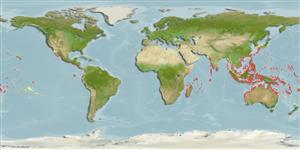Actinopterygii (ray-finned fishes) >
Beloniformes (Needle fishes) >
Hemiramphidae (Halfbeaks)
Etymology: Hyporhamphus: Greek, hypo = under + Greek, rhamphos = beak, bill (Ref. 45335).
Environment / Climate / Range
Ecology
Marine; reef-associated; depth range 0 - 6 m (Ref. 86942). Tropical, preferred ?
Indo-Pacific: Red Sea and East Africa through the Indian Ocean islands to western Australia, New Guinea, Philippines, and islands of Oceania. Not found in Hawaiian islands, and apparently absent from Indo-Malayan Archipelago. Has been mentioned in the literature under other names, particularly Hyporhamphus erythrorinchus and Hyporhamphus dussumieri (Ref. 10943).
Length at first maturity / Size / Weight / Age
Maturity: Lm ?, range 13 - ? cm
Max length : 38.0 cm SL male/unsexed; (Ref. 54980)
Found chiefly around coral reefs (Ref. 58534) and islands but extends a little further from shore than Hyporhamphus (R.) dussumieri which has a similar range (Ref. 10943). Found in schools (Ref. 9710). Feeds on zooplankton (Ref. 43448) also small fishes and detritius organic matter (Ref. 89972). Eggs covered with adhesive filaments to assist in attaching to floating and benthic objects (Ref. 43448).
Life cycle and mating behavior
Maturity | Reproduction | Spawning | Eggs | Fecundity | Larvae
Collette, B.B. and J. Su, 1986. The halfbeaks (Pisces, Beloniformes, Hemiramphidae) of the Far East. Proc. Acad. Nat. Sci. Philadelphia 138(1):250-301. (Ref. 10943)
IUCN Red List Status (Ref. 115185)
CITES (Ref. 94142)
Not Evaluated
Threat to humans
Harmless
Human uses
More information
ReferencesAquacultureAquaculture profileStrainsGeneticsAllele frequenciesHeritabilityDiseasesProcessingMass conversion
Tools
Special reports
Download XML
Internet sources
